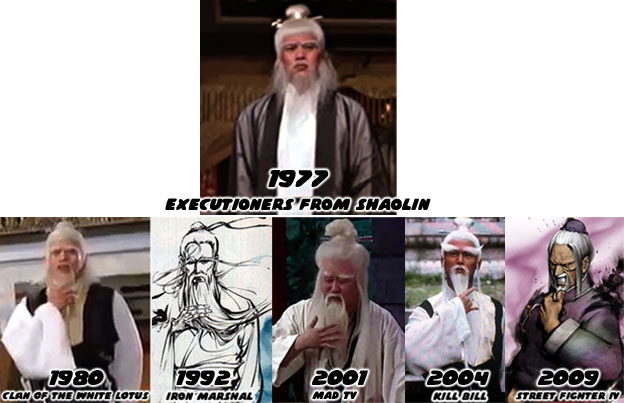
Whether a martial arts character was supposed to be serious or funny, whether in film, comic, game or television, the pull of Hong Kong cinema was inescapable. Martial artists and the various forms of fighting as presented in any media were almost all universally based on a character that had appeared in a classic martial arts film.
Pai Mei was one such archetype. He was created in the 1977 film Executioners from Shaolin. This character sported a head of long white hair and long white eyebrows. His uniform was pristine and he was very arrogant in his abilities. The character seemed impervious to harm and was impossible to defeat in hand-to-hand combat. Pai Mei was a caricature of kung-fu masters from ancient China. His appearance was rooted in Chinese Opera and an imaginative film wardrobe department. He looked fantastic because it was more appealing on the screen. The earliest photos of kung-fu masters looked nothing at all like Pai Mei. The men appeared very ordinary. They may have been able to shatter bones with a single punch but were so unassuming that we would have never guessed. Nobody in HK cinema ever looked this bland. The bright, ornate costumes featured in the films from the late '60s and early '70s were directly responsible for the designs used in videogames. Pai Mei was copied time and time again not only in China but in Japan and the US as well. Everything from the look to the mannerisms of the character was so familiar to moviegoers that he could be used in a homage or parody depending on the project. Very few non-corporate or non-cartoon characters could claim to have the same global recognition as a kung-fu archetype. Pai Mei was just one of many film characters that influenced the Street Fighter cast.

The life of Mas Oyama may have influenced the narrative of Street Fighter however the supporting characters and universe were inspired more by action films. The 1975 film the Master of the Flying Guillotine was undoubtedly one of the most important films referenced by the designers at Capcom in the 1980's. Both the Guillotine and its predecessor the One Armed Boxer had great action sequences and a wonderfully diverse cast of characters, including masters of kung-fu, muay thai, karate, judo and other forms.
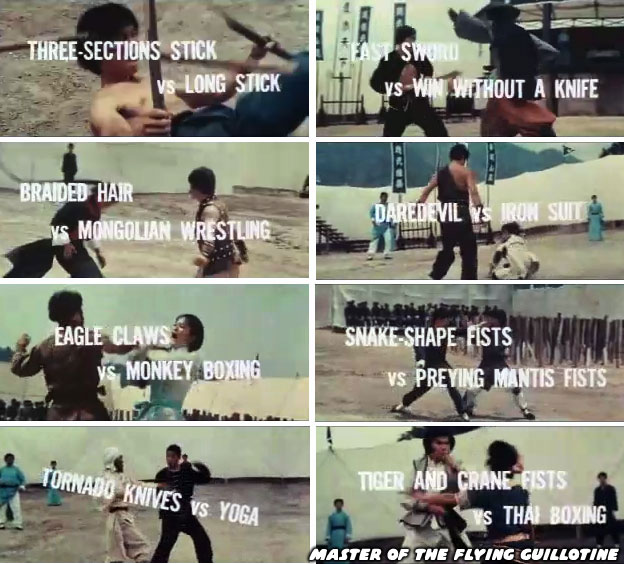
The Master of the Flying Guillotine was notable because it pulled together the martial artists in a tournament setting. When the burly Mongolian wrestler fought the petite Chinese fighter it predated the Zangief versus Chun-Li matchup by more than 15 years. The arrogant muay thai fighter and stretchy limbed yoga master were paralleled by Adon and Dhalsim many years later as well. The use of an international tournament to determine the best fighter was basis for Street Fighter II and the original Mortal Kombat. In SF II this tournament was actually a front for a bigger plot in which the main character, Ryu was being trapped by a more powerful character. In the Master of the Flying Guillotine the tournament happened to take place at the same time an assassin was after the One Armed Boxer. Vega (M. Bison in the US) was pulling the strings and using his three bosses to ensure victory in SF II. In the film the blind monk was aided by a couple of tournament participants in tracking down the One Armed Boxer. The tournament format was not a new idea, but it was a good plot device bringing the various characters and styles together in one place. What cinema did was put a human face on these archetypes and infused them with personality.
Martial arts cinema in China differed from action films in other countries. The wuxia stories applied to men and women equally. Females in Hong Kong cinema often held their own against the men. This distinction should be noted since women were usually the prize for the action stars in the west. There were female fighters celebrated in myth and legend in China almost as much as men. The daughter of the tournament sponsor in the Guillotine movie had entered the contest herself. The historical figure Hua Mulan was said to have exceptional skill in battle and served in the army for 12 years on behalf of her father in ancient times. In fact Wing Chun, the style of boxing taught by Yip Man, was created by a woman. The godmother of martial arts cinema was Angela Mao. She was the first international movie female fighting star. There had been other women with great fighting scenes in earlier movies however Angela was the star of Lady Whirlwind. The 1973 film actually predated the Master of the Flying Guillotine! It pitted the petite master of kung-fu against masters of different styles including judo and karate. She demonstrated that a perfect fighting form could conquer the strength and size of any man. Angela was the mold from which tremendous characters like Chun-Li were cast.
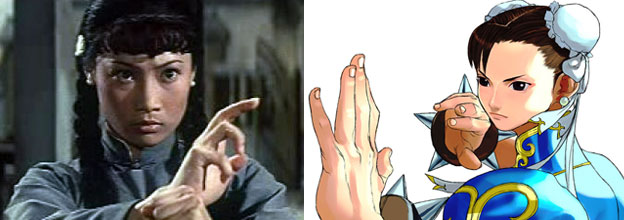
The HK movie industry could be kind to stars like Angela Mao but turn its back on others like Jimmy Wang Yu. The characters they created would live on however and be embraced the world over. Hong Kong cinema was also known for influencing fight choreography in Eastern and Western films. Martial arts cinema could actually be traced back to The Burning of the Red Lotus Temple, an incredibly long series from 1928. The actors were trained martial artists, mostly from the Chinese Opera. They choreographed basic fight scenes and even sword battles. The film made use of early special effects techniques including some wire work. It was interesting to see wuxia type epics during this era because the films were challenged by the government at the time for promoting the ideas of superstition and anarchy.

Where the format really took off was post-WWII. The Chinese were eager to rebuild and find a distraction from the horrors of the war. They, like many other countries, turned to film. The True Story of Wong Fei Hung was a series of movies beginning in 1949. It chronicled the life and adventures of Wong Fei Hung, the doctor and martial arts master made famous in more contemporary films including Once Upon a Time in China and the Iron Monkey. The doctor was celebrated as a folk hero with amazing martial prowess. Reaching a mythical level of fame allowed various comics, movies, television shows and even videogames to be made about him.
Not all of the early films were grounded in Chinese Opera or real-life heroes. Many of the most memorable films introduced fantastic characters with special powers to audiences. One film that exploited special effects and martial arts archetypes was the Furious Buddha's Palm. This film predated the Master of the Flying Guillotine by a decade. The 1965 film presented the types of stories and characters that audiences had been reading about in manhua titles. The masters could harness and expel chi as energy. It protected them from attack and allowed them to do amazing things like running on air and stopping weapons with their bare hands.
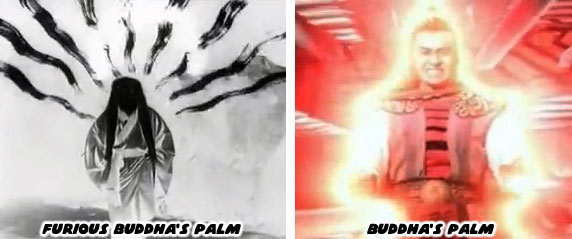
The film was remade in 1982 and the title shortened to just Buddha's Palm. The special effects were improved considerably. The films were important for the development of manhua, manga and fighting games. They were some of the first wuxia titles that presented the fabled super techniques of the qigong masters in a visual format. This included characters that were able to heal as well as harm people using advanced chi manipulation. Energy waves, beams of light and other forces could be seen emanating from the hands of the martial arts masters. These things were seen in film years before Street Fighter was even conceived. The influences of these characters and their amazing powers not only shaped Japanese designers but western filmmakers as well. Big Trouble in Little China, a John Carpenter film from 1986, put wuxia legends in a modern context. The combination of elements was fantastic and completely over-the-top; martial arts masters were deflecting bullets with their kung-fu, ancient monsters lived under the streets of Chinatown and secretive gangs ran the streets with guns and magic. Audiences accepted that these legendary fighters still existed in some hidden part of the world and mobsters used them to terrorize the public.
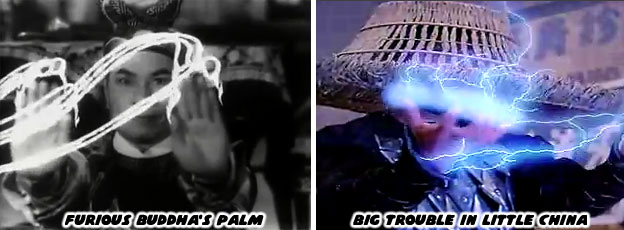
It was not hard to imagine that the juxtaposition of the classic and the modern themes would also work in a videogame. After all, what would happen if a Japanese man wearing a white gi and black belt walked into a pub looking to fight the strongest mohawk-haired punk? People would probably laugh and then call the police. A scenario like this was a good set-up for a martial arts film but was actually the backdrop between Ryu and Birdie in the original Street Fighter. By coincidence(?) the original Street Fighter was released in 1987, a year after Big Trouble in Little China. Midway would concede that Mortal Kombat was inspired by this movie and various other martial arts films as well.
Buddha's Palm visualized the fa jin energy attacks and moreover featured elements that predated Hokuto no Ken. The master of the Dark Moon Clan shot blue energy blasts in the shape of two outstretched hands, for all intents and purposes this was the original hadoken. The villain, Heavenly Foot, shot yellow beams of energy in the shape of daggers. Even in the original black and white film there were energy attacks of different shapes. Some were lightning bolts, others were waves and still others were shaped like chains. Each of these energy blasts did a different thing and had to be defeated with different techniques or by combining forces.
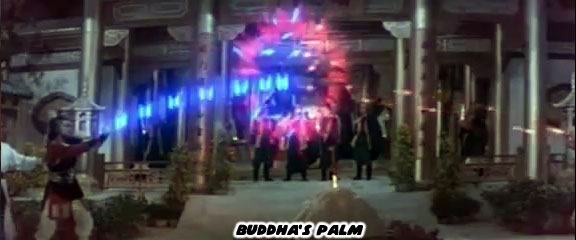
Street Fighter was built around different fighting styles and archetypes. It was not expected that every fighter was a master of chi manipulation. Some that could not throw fireballs still had ranged attacks. In Street Fighter Zero the mercenary Rolento threw knives and the convict Cody threw rocks. This was acceptable given the type of fighters that they were. The diversity of moves allowed players to exploit weaknesses in every style. Even special moves had their own limitations. A fireball attack could be jumped over and a rising uppercut could be ducked under. This left the player with all sorts of strategies for offensive as well as defensive playing. No style was absolutely perfect and no form was completely impenetrable. This understanding was the driving force behind the balance that SF would become famous for.
Buddha's Palm was not only an influential film, it was also a defining manhua series. It was created by Tony Wong in 1982, the same year as the movie remake. However Mr. Wong's version had nothing to do with the movie. Instead it was inspired by The Story of the Sword and the Sabre aka Heaven Sword and Dragon Sabre. The manhua series featured Lung Kim-fei, an orphan who was rescued by a Shaolin Monk after a violent clash between the Mongolians and Chinese. The young hero became a master of the Buddha's Palm, the most powerful technique in all kung-fu. It was a form of fighting that was not only physically impressive but could be used to fight off demons and destroy evil.
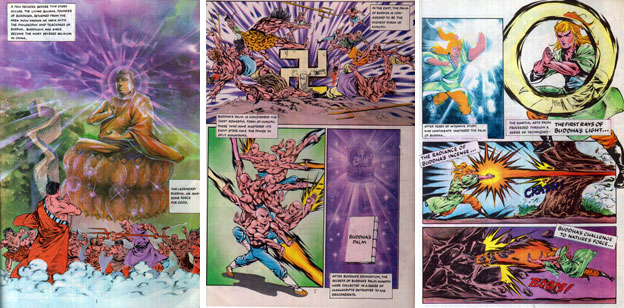
This series was a template for many fantastic manhua and manga spectacles. It featured characters of all types including giants and man-beasts fighting against humans. These characters could perform chi blasts and do the other fantastic things featured in HK cinema. The Buddha's Palm was not a singular technique but a series of techniques that had different properties. Lung could shoot energy from his hands, it was powerful enough to split rocks and cut down trees. He could also use his power to fly, destroy opponents with a yell and even cause earthquakes. This collection of powers was very similar to the things that Western comic book super heroes had. Like those heroes Lung was in a constant battle against evil and always defending the powerless.
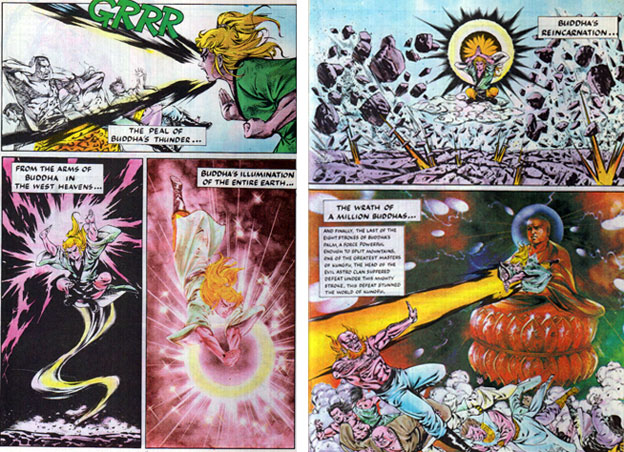
Not every fighter had fantastic powers. In order to ground fighters into reality many manga characters had to put a unique spin on the existing fighting arts. See how creators sometimes made things up for the sake of telling a story in the next blog. As always if you enjoyed this blog and would like to sponsor me please visit my Patreon page and consider donating each month, even as little as $1 would help make better blogs and even podcasts!

No comments:
Post a Comment